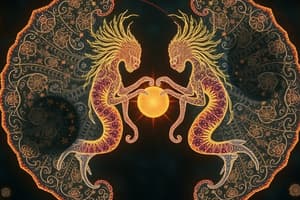Podcast
Questions and Answers
Which process describes the reproduction method used by prokaryotes?
Which process describes the reproduction method used by prokaryotes?
- Cytokinesis
- Mitosis
- Binary fission (correct)
- Meiosis
What is the primary purpose of mitosis in eukaryotic organisms?
What is the primary purpose of mitosis in eukaryotic organisms?
- Genetic variation
- Repair and growth of tissues (correct)
- Production of gametes
- Cellular respiration
In which phase of mitosis do the chromosomes align at the cell's equator?
In which phase of mitosis do the chromosomes align at the cell's equator?
- Prophase
- Anaphase
- Telophase
- Metaphase (correct)
Which of the following best describes cytokinesis?
Which of the following best describes cytokinesis?
What represents the final step of the cell cycle?
What represents the final step of the cell cycle?
What do somatic cells refer to?
What do somatic cells refer to?
Which process results in the production of sperm and ova?
Which process results in the production of sperm and ova?
Which stage of mitosis involves the disassembly of the nuclear envelope?
Which stage of mitosis involves the disassembly of the nuclear envelope?
What initiates the formation of the mitotic spindle during prophase?
What initiates the formation of the mitotic spindle during prophase?
What is the purpose of the spindle checkpoint during metaphase?
What is the purpose of the spindle checkpoint during metaphase?
Which process occurs during anaphase?
Which process occurs during anaphase?
What happens to the nuclear envelope during prometaphase?
What happens to the nuclear envelope during prometaphase?
In cytokinesis for animal cells, what structure is formed to assist in the division of the cytoplasm?
In cytokinesis for animal cells, what structure is formed to assist in the division of the cytoplasm?
Which of the following correctly describes the sequence of events during telophase?
Which of the following correctly describes the sequence of events during telophase?
What is the role of motor proteins during anaphase?
What is the role of motor proteins during anaphase?
Flashcards
Cell Division in Prokaryotes
Cell Division in Prokaryotes
Cell division in prokaryotes, like bacteria, is a form of reproduction where a single cell duplicates its DNA and then splits into two new cells.
Cell Division in Eukaryotes
Cell Division in Eukaryotes
Cell division in eukaryotes (like plants and animals) isn't just about reproduction, but also growth, repair, and replacing cells.
Mitosis
Mitosis
A type of cell division that produces two identical daughter cells from a single parent cell.
Meiosis
Meiosis
Signup and view all the flashcards
Somatic Cells
Somatic Cells
Signup and view all the flashcards
Prophase
Prophase
Signup and view all the flashcards
Cytokinesis
Cytokinesis
Signup and view all the flashcards
Cell Cycle
Cell Cycle
Signup and view all the flashcards
Interphase - DNA Replication
Interphase - DNA Replication
Signup and view all the flashcards
Prophase - Chromosome Condensation
Prophase - Chromosome Condensation
Signup and view all the flashcards
Metaphase - Chromosomes Align
Metaphase - Chromosomes Align
Signup and view all the flashcards
Anaphase - Sister Chromatids Separate
Anaphase - Sister Chromatids Separate
Signup and view all the flashcards
Telophase - Daughter Nuclei Form
Telophase - Daughter Nuclei Form
Signup and view all the flashcards
Cytokinesis - Cytoplasm Divides
Cytokinesis - Cytoplasm Divides
Signup and view all the flashcards
Study Notes
Cell Division: Mitosis and Meiosis
- Cell division is crucial for reproduction and growth in organisms.
- Prokaryotes reproduce through binary fission, replicating DNA and dividing into two new organisms.
- Eukaryotes use cell division (mitosis) to replace cells and repair tissues.
- Mitosis produces two identical daughter cells from one parent cell.
- Mitosis creates somatic cells (body cells).
- Meiosis produces gametes (sperm and ova).
Process of Cell Division (Mitosis)
- Involves DNA replication, cytokinesis, and cell division.
- Takes approximately an hour to complete.
- Produces genetically identical daughter cells.
- Used for growth, repair, and replacement of cells.
Stages of Mitosis
- Interphase: Growth and DNA replication. Sister chromatids form. Centrosomes duplicate.
- Prophase: Chromatin condenses into chromosomes. Mitotic spindle forms and centrosomes move to opposite poles. Nuclear envelope begins to break down.
- Prometaphase: Chromosomes continue condensing, kinetochores form at centromeres. Microtubules attach to kinetochores. Nuclear envelope fully breaks down.
- Metaphase: Chromosomes align along the metaphase plate (equator). Spindle checkpoint ensures proper chromosome alignment.
- Anaphase: Sister chromatids separate and move to opposite poles. Spindle fibers lengthen the cell.
- Telophase: Daughter nuclei begin to form. DNA begins de-condensing. Mitotic spindle breaks down. Cytokinesis begins.
- Cytokinesis: Cytoplasm divides, forming two separate daughter cells. Animal cells form a cleavage furrow, plant cells form a cell plate.
- After cytokinesis, the daughter cells re-enter interphase to repeat the cycle.
Key Differences: Mitosis vs. Meiosis
- Mitosis produces somatic cells, meiosis produces gametes.
- Mitosis creates identical copies of parent cells. Meiosis creates genetically unique gametes.
- Mitosis has one division, meiosis has two.
Cell Division Purposes
- Replacing dead cells
- Repairing injuries
- Supporting organism growth
- Generating new cells
- In humans, nearly two trillion cells divide daily.
Studying That Suits You
Use AI to generate personalized quizzes and flashcards to suit your learning preferences.





